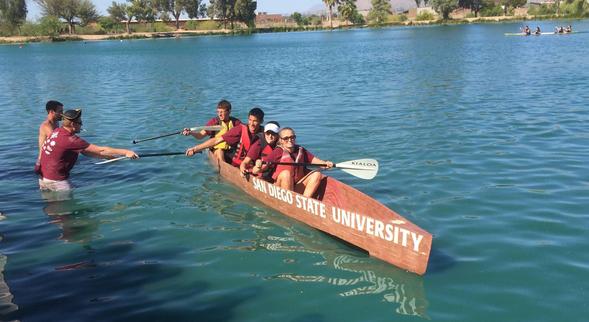Cementing a Legacy
Civil engineering chair Janusz Supernak recently led his 25th consecutive team of students to an annual regional engineering competition, and the team did him proud.

The Curious Aztec takes you behind the scenes of scientific investigation and discovery taking place at San Diego State University.
Frontiersmen Lewis and Clark might have opted for canoes dug out of sturdy cottonwoods, but modern engineers prefer solid concrete. At least that’s true of those competing at the American Society of Civil Engineers’ annual Pacific Southwest Conference, the latest iteration of which was held last month in Tucson, Arizona. The three-day competition pits undergraduate and graduate civil engineering students from 18 regional universities against one another in a variety of challenges including concrete canoe races, concrete bowling, surveying, bridge building, water purification and transportation design.
San Diego State University civil engineering professor and department chair Janusz Supernak led an SDSU team of 78 students to the competition for his 25th consecutive year.
“Seeing these students train and compete and do well, it makes me feel like a proud parent,” he said.
Engineering exercise
SDSU acquitted itself well in this milestone competition, coming in fifth place overall (Cal Poly San Luis Obispo took first place). Aztecs won outright in several contests, coming in first place in surveying, concrete bowling—“It’s like regular bowling, but the ball is made of concrete,” Supernak explained—and a transportation project challenge.
The latter victory particularly impressed Supernak, a highly regarded expert in the field of transportation engineering. This particular challenge is new to the conference and consists of students mocking up engineering plans for a highway connection between roads in Tucson. Competitors drafted plans that took into account the existing structures, road speed, centrifugal forces, cost, and other factors.
“Winning this challenge was very gratifying for me because that’s my field,” Supernak said.
In the competition’s signature event, concrete canoeing, teams design the shape of their canoes, then mix their own concrete and craft their boats. The competitors must balance the demands of straight speed and turning ability, as well as weight and structural integrity.
“It’s about optimization of all kinds of engineering elements, such as materials and reinforcement,” Supernak said.
Floating to victory
Inevitably, some boats sink every year. They’re made of concrete, after all. Luckily, this year, SDSU’s canoes floated admirably.
SDSU’s team came in fourth place overall. This was actually a good showing for SDSU, Supernak said, because concrete canoe has not typically been one of the team’s strong suits. The Aztecs had a particularly strong performance in one portion of the challenge, the women’s concrete canoe sprint, coming in second place.
Spirit of competition aside, the conference and its games are great for budding engineers looking to hone their talents and make professional connections they’ll need as they graduate and embark on their careers.
“The competitors develop so many skills that count later in the profession, especially networking skills,” Supernak said.



